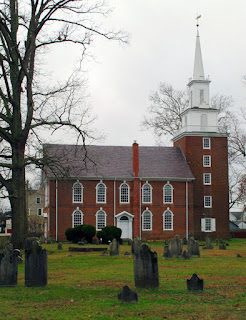 |
| Ed Snyder (Photo by Robert Reinhardt) |
The Greater Philadelphia area is replete with cemeteries, big and small. I’ve traveled quite a bit around the area in the past fifteen years and have not visited them all! Back in the olden days – like ten years ago – you had to rely on paper maps and written directions to find the graveyard you were after. One of the new technologies that makes these sacred tracts of land easy to locate these days are the GPS map Apps in smart phones. For example, with the Apple iPhone 6, simply type in the words “cemetery near Philadelphia” and the map lights up with little red push pins all over (indicating cemeteries in this region) and a cursor showing your location (let’s assume you are driving a car). Simply drive toward one of the red pins, and your cursor on the map will follow!
When you find yourself somewhere in the swamps of Jersey,
you need all the help you can get. Guardian angels notwithstanding, the smart phone map app can be very useful. As we drove south across the Barry Bridge on
Route 322, we didn’t see any cemetery dots for about twelve miles, until we
came to the Swedesboro/Mullica Hill area. We found and tramped through three
cemeteries that day.
Lake Park Cemetery
Our first stop was Lake Park Cemetery, a smallish suburban
cemetery in the town of Woolwich, “situated high on a wooded hill and
overlooking the placid waters of Lake Narriticon,” according to the Swedesboro
cemetery guide brochure, “Alive with History.” This informative text goes on to say that Lake Park “has been considered one of
the most beautiful and enduring cemeteries in the state.” Hmm. Perhaps winter
is not the peak season here. I should probably return when the trees and
flowers are in bloom.
 |
| Toy cars on a child's grave |
 |
| Water pump, Lake Park Cemetery |
 |
| Photo by Robert Reinhardt |
Trinity Episcopal Church Cemetery
 |
| Trinity Episcopal Church and grave yard |
The church’s graveyard has been here since 1703. According to
the informative online brochure Swedesboro NJ – Alive with History,
“Many graves of the early Swedes, Finns, Native Americans and African Americans
are now un-marked but plots are shown on a parchment map dating to the
mid-1800s.” However, headstones dating back to 1721 are still standing. One of
the grave stones no longer standing is that of Eric Mullica, who arrived on
this continent in 1638. His sons founded the nearby town of Mullica Hill. A
commemorative plaque stands in the graveyard in memory of these pioneer
settlers.
 |
| Mortonson-Schorn Log Cabin, Swedesboro |
 We don’t see a lot of ornamentation here in the old Trinity Church grave
yard, just standard headstones. The first thing I noticed was a newer red
marble headstone inscribed, “My Mother’s Grave” near the church, and a small
old log cabin on the far (east) side of the graveyard. Turns out this
cabin is “one of the oldest original log cabins of early Swedish-Finnish architecture
in the United States” (ref.).
Known as the Mortonson-Schorn Log Cabin, it was built in 1654 by “Morton
Mortonson, the grandfather of John Morton, who signed the Declaration of
Independence … Prior to and during the Civil War, the Mortonson-Schorn Cabin
was used as a station for the Underground Railroad.”
We don’t see a lot of ornamentation here in the old Trinity Church grave
yard, just standard headstones. The first thing I noticed was a newer red
marble headstone inscribed, “My Mother’s Grave” near the church, and a small
old log cabin on the far (east) side of the graveyard. Turns out this
cabin is “one of the oldest original log cabins of early Swedish-Finnish architecture
in the United States” (ref.).
Known as the Mortonson-Schorn Log Cabin, it was built in 1654 by “Morton
Mortonson, the grandfather of John Morton, who signed the Declaration of
Independence … Prior to and during the Civil War, the Mortonson-Schorn Cabin
was used as a station for the Underground Railroad.” |
| Ivy, ferns, flowers, and other leafy designs |
The “new” cemetery’s most striking detail, I thought, was the
brick-columned entrance way, with rusting iron ornamental lamps atop the
columns. Flags from a previous Memorial Day lay inside the gate, near a rusty
old water faucet.
St. Joseph’s Roman Catholic Church Cemetery
Directly across Church Street from the “new” Trinity
Episcopal Church Cemetery we found St. Joseph’s Roman Catholic Church Cemetery.
Originally I thought it might be yet another extension of Trinity, until I
noticed the congregation on nearby Broad Street letting out, with the Catholic
priest greeting those holier than I, those who chose to worship mass on Sunday.
 |
| Reverend Antonio Cassese's grave marker, St. Joseph’s Church Cemetery |
 |
| Passion Flower engraved in granite |
“Passion flower - The elements of the passion of Christ: the
lacy crown—the crown of thorns; the five stamens—the five wounds; the 10
petals—the 10 faithful Apostles."
Hmm. “Ten” faithful apostles? I thought it was eleven
(twelve minus Judas)? Oh well, you learn something every day. After our cemetery
tours, Bob and I adjourned to a local diner for a late lunch. Jersey diners are
typically worth the trip. Visually, I include them in the garish roadside
attractions for which New Jersey is well known. The food on the other hand, can
be hit or miss. After ordering the breakfast burrito at this place I realized
that I too, could easily prepare a breakfast burrito. What they served was
pretty much what I would have made with basic ingredients found in the fridge –
sausage links, onions, and store-bought salsa. About as basic and
plain as you would expect from the Swiss and Finns, I suppose. But hey, at least they didn't use swiss cheese in the burrito!
References and Further Reading:






















